Key takeaways:
- Reparations politics involves recognizing and addressing historical injustices, with a multifaceted approach beyond financial compensation, including education and community investments.
- Effective allyship emphasizes active listening, accountability, and ongoing learning, ensuring marginalized voices are prioritized and respected.
- Challenges in allyship include recognizing privilege, navigating discomfort, and maintaining sustained commitment to support movements for reparations.
- Measuring the impact of allyship involves observing changes in community engagement and building genuine relationships that lead to meaningful connections and progress.

Understanding reparations politics
Reparations politics can often feel like a maze, deeply intertwined with historical injustices and systemic inequalities. Reflecting on my own experiences, I sometimes wonder how many of us truly grasp the gravity of these issues. I remember a discussion where a friend asked, “What if reparations could transform not just the lives of those directly affected, but society as a whole?” It pushed me to think beyond numbers or payouts and consider the deeper reparative relationships that need to be built.
At its core, reparations seeks to rectify past wrongs, particularly against marginalized communities. It’s about acknowledging the pain that has rippled through generations. I’ve witnessed the hesitance in conversations surrounding this topic; many people shy away, fearing judgment or a lack of understanding. But isn’t it crucial to confront these feelings? Engaging with the historical context can open doors to empathy and lead to constructive dialogue.
As I delve deeper into reparations politics, I’m struck by how it combines moral responsibility with policy initiatives. The diversity of opinions can be overwhelming, and I often remind myself that this is a collective journey. I recently participated in a workshop where we envisioned what reparative justice might look like in our community. It was enlightening; we identified not just financial reparations, but also investments in education, healthcare, and community building. This multifaceted approach made me realize that reparations isn’t a singular solution—it’s a complex interplay of recognition, accountability, and healing.
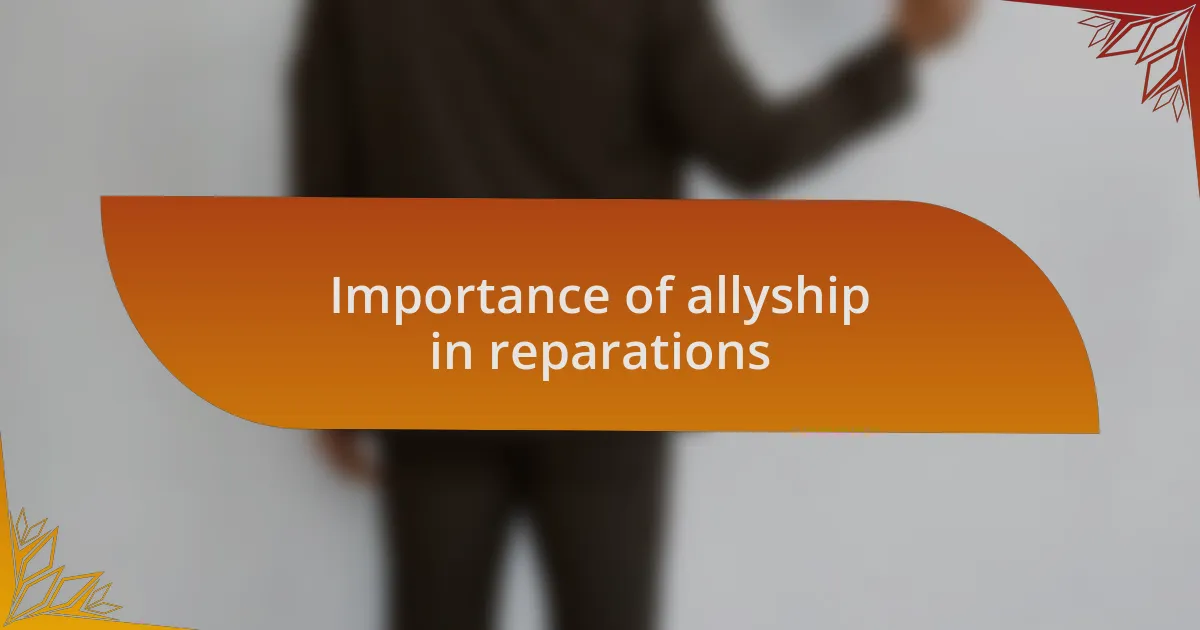
Importance of allyship in reparations
Allyship is crucial in the realm of reparations because it amplifies marginalized voices that might otherwise remain unheard. I’ve experienced firsthand how conversations can shift when allies actively listen and uplift the narratives of those impacted by historical injustices. One time, during a community meeting, I noticed how the room felt different—it was heavier, yet richer with understanding—when non-affected allies took the time to acknowledge the shared history and its implications. Does this simple act of listening not open the door for genuine conversations about reparations?
Moreover, allyship provides a bridge to collective action. I recall participating in a march focused on reparative justice, where allies showed their support not just by standing alongside us but by advocating for policy changes as well. It was empowering to see people using their privilege to challenge systemic barriers that perpetuate inequalities. Isn’t it fascinating how, together, we can shift narratives and influence decision-makers when allies stand in solidarity?
Finally, the importance of allyship extends beyond mere support; it encourages accountability and shared responsibility. I once had a discussion with an ally who asked how they could help without overshadowing the voices of those directly affected. It highlighted the essential balance in this work—being proactive while always prioritizing the experiences of marginalized communities. This partnership is not just about standing beside each other; it’s about learning, evolving, and ensuring that the fight for reparations is a shared endeavor.
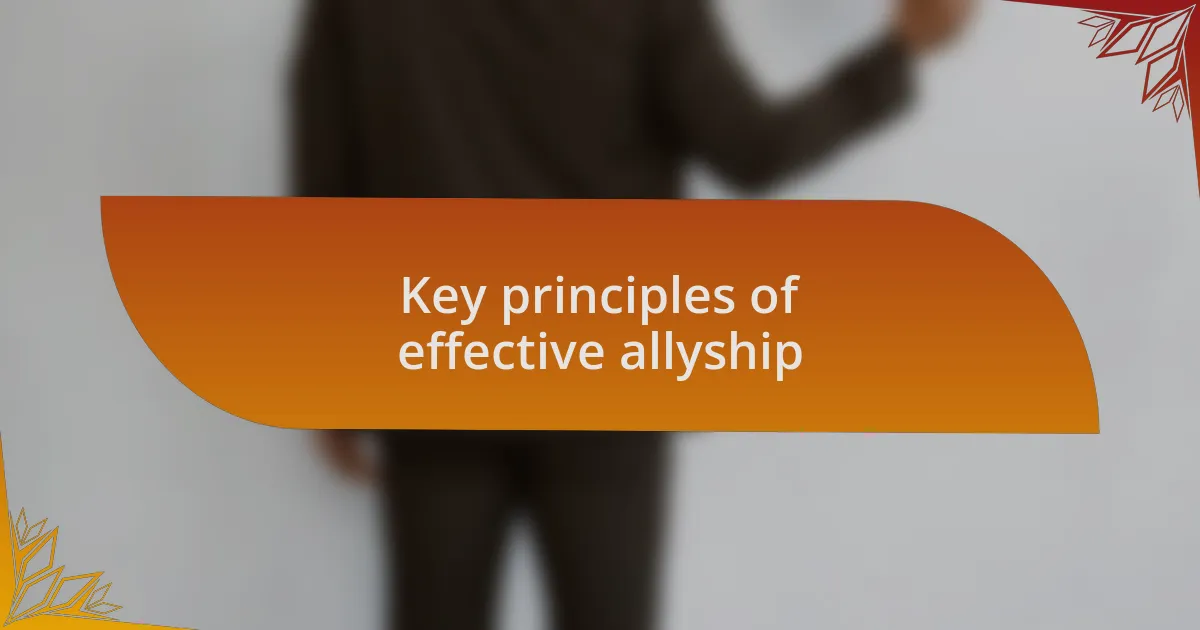
Key principles of effective allyship
One key principle of effective allyship is understanding the privilege I hold and using it to advocate for those without the same advantages. I remember a time when a friend, who had benefited from various societal privileges, began to actively engage with the issues surrounding reparations. This journey transformed their outlook and allowed them to use their voice to advocate for systemic change. Isn’t it powerful when individuals realize that their privilege can serve as a tool for social justice rather than a barrier?
Another essential aspect is the willingness to learn continuously. I’ve seen allies who approach conversations with humility, recognizing that they don’t have all the answers. I once attended a workshop where participants shared their experiences with reparations; instead of dominating the discussion, my ally asked thoughtful questions and listened intently. This reminded me that effective allyship is an ongoing process; it’s not just about stepping in when it’s convenient but being committed to understanding and addressing the issues consistently. Isn’t that a crucial trait for anyone wanting to make a difference?
Finally, accountability in allyship cannot be overstated. I often reflect on a time when a few allies and I collaborated on a project aimed at raising awareness about reparations. We agreed upfront to hold each other accountable—in our discussions and actions—as a way to ensure that the needs and voices of marginalized communities remained central. It was challenging at times, but that commitment deepened our effectiveness. Doesn’t that level of accountability elevate the movement and show true dedication to the cause?
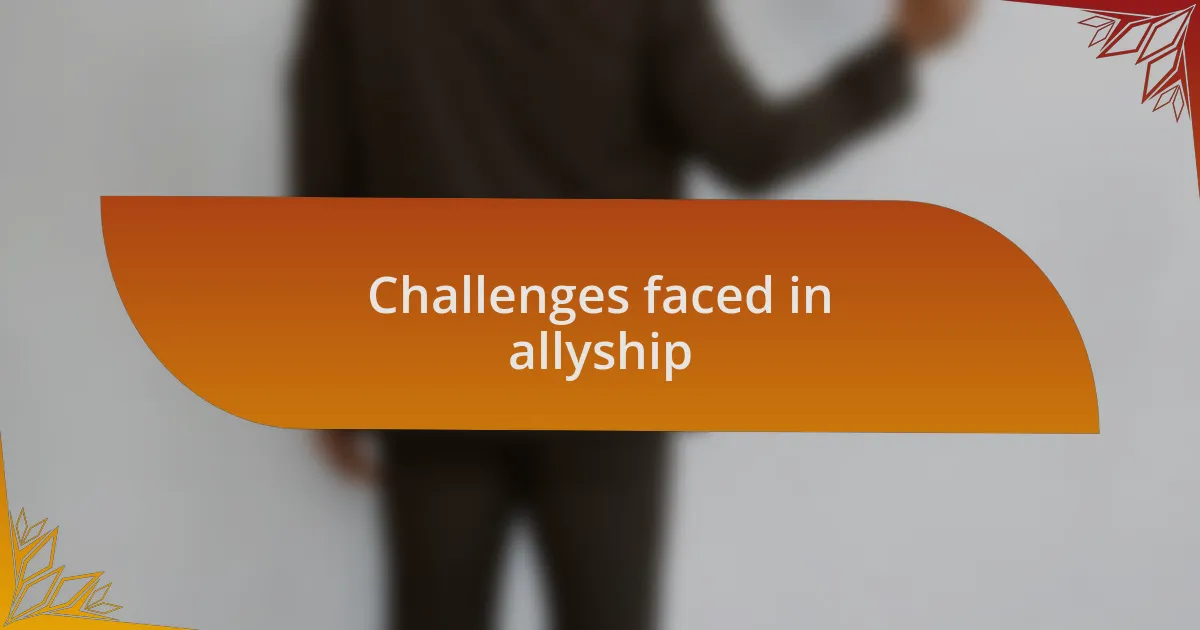
Challenges faced in allyship
Challenges in allyship often emerge from a lack of understanding of the complexities involved. I recall a moment at a community meeting where an ally unintentionally dominated the discussion, dismissing the voices of those directly impacted by reparations. This experience highlighted a common dilemma: allies sometimes struggle to recognize when to step back and allow marginalized voices to be heard. Isn’t it interesting how the intent to help can sometimes overshadow the actual needs of those we seek to support?
Another significant challenge is navigating discomfort. I once took part in a dialogue about reparations that touched on uncomfortable historical truths and systemic injustices. I noticed some allies shifting uncomfortably in their seats, grappling with guilt or defensiveness. This reaction made me realize that recognizing and confronting the unease associated with allyship is crucial. How do we move past that discomfort and engage more openly? It starts with acknowledging our feelings rather than avoiding them, fostering a safe space for dialogue.
Additionally, maintaining sustained commitment can be challenging. I remember a time when I organized gatherings to discuss reparations, only to see some allies fade away after the initial excitement wore off. It felt disheartening because consistency is key in allyship. How do we keep the momentum going? I’ve learned that regular check-ins with allies and community members can create a sense of accountability, reminding everyone of our shared responsibilities. Isn’t consistency the true test of dedication?
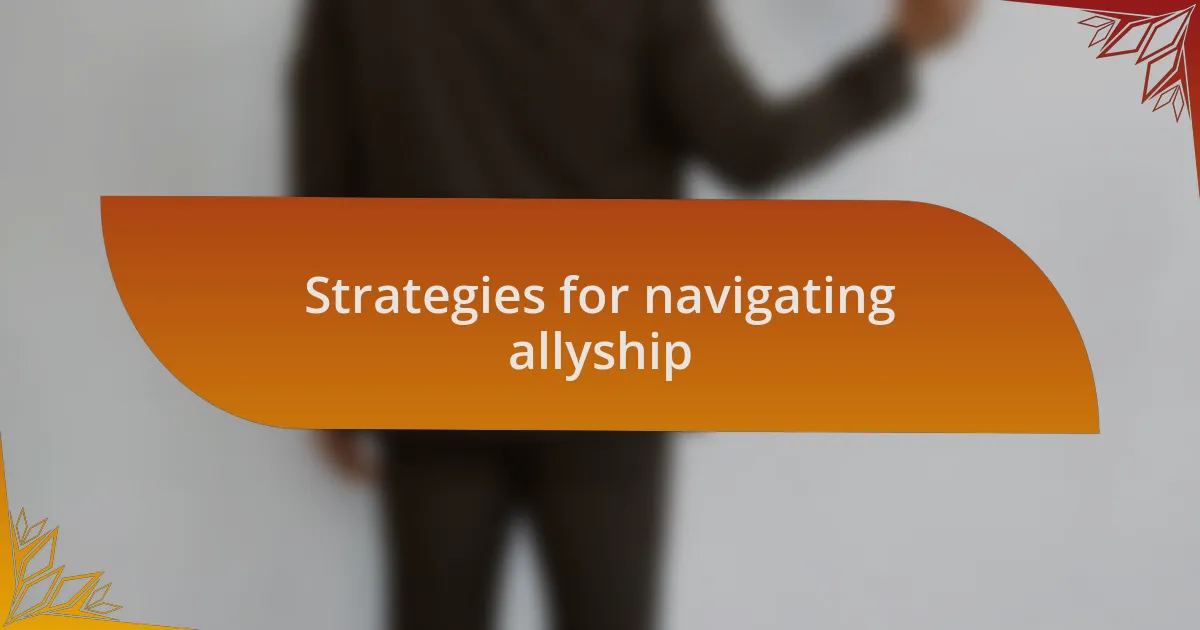
Strategies for navigating allyship
When navigating allyship, one effective strategy is prioritizing active listening. I recall an instance during a workshop when I consciously chose to remain silent while a community member shared their experience with reparations. Instead of jumping in with my own thoughts, I focused on absorbing their message. This not only validated their feelings but also deepened my understanding of the issue. Have you ever noticed how powerful it can be to simply listen without the urge to respond?
Equally important is the practice of self-reflection. I engaged in a personal exercise where I wrote down my motivations for being an ally. This process revealed some biases I hadn’t acknowledged and prompted me to examine my privilege more closely. How often do we pause to reflect on our intentions? I believe that honest self-assessment can pave the way for more genuine and effective allyship.
Building connections with impacted communities is another crucial strategy. I remember reaching out to local activists to learn about their needs and goals before planning events. This approach not only strengthened our relationships but also ensured that our efforts were genuinely aligned with the community’s desires. How can we foster deeper connections with those we wish to support? It starts by showing up, listening, and committing to ongoing collaboration.

Personal experiences of effective allyship
In my experience, one moment that stands out in my journey of allyship occurred during a community rally. I had volunteered to help but found myself on the sidelines, observing the power of collective action. The energy in the crowd was palpable, and I realized how my role was to support rather than overshadow those directly affected. Have you ever felt that sense of empowerment just by being present?
There was another time when I engaged in a candid conversation with a friend from a marginalized group. We talked about the misconceptions people often have about reparations and how essential it is to address these ideas directly. I learned that sometimes, simply sharing a meal while discussing tough topics can break barriers and build trust. I often wonder how many opportunities we miss to learn, just by not initiating these conversations.
A particularly impactful experience for me was participating in a community art project aimed at raising awareness about historical injustices. Collaborating with artists from diverse backgrounds opened my eyes to how creativity can be a powerful vehicle for change. I found myself reflecting on my own artistic voice and how it could support these narratives. Have you thought about how your passions can intersect with allyship efforts?
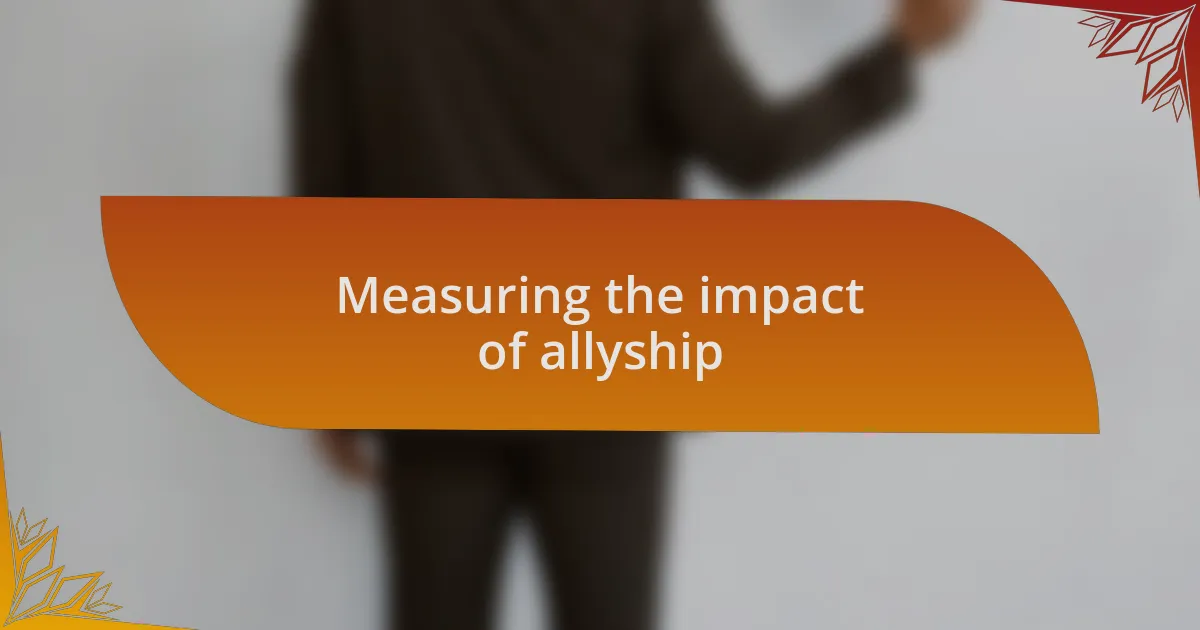
Measuring the impact of allyship
Measuring the impact of allyship can be challenging, yet it’s crucial for understanding our collective progress. In one instance, I volunteered for a grassroots organization focused on racial justice and noticed that after my participation, the local community began to engage more robustly in discussions around systemic issues. I couldn’t help but ask: did my presence alone spark that interest, or was it part of a larger movement?
In my experience, allyship can often be quantified through the relationships and networks built along the way. For example, after collaborating with a group from diverse backgrounds, I observed how their shared stories fostered a greater sense of belonging. The heartfelt thank-you notes I received from participants made me realize that tangible connections can highlight the effectiveness of allyship. Have you ever felt the weight of a simple acknowledgment transform your understanding of your impact?
Another way to gauge allyship’s effectiveness is by observing shifts in community participation and activism. During a recent initiative aimed at addressing housing inequities, I saw community turnout double from previous events. It was a significant reminder that consistent allyship can translate into mobilizing voices that demand change. The question lingers: how can we continue to build momentum from these successes to ensure lasting impact?